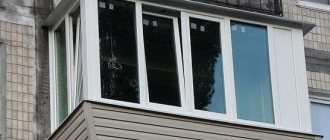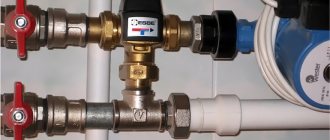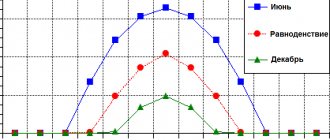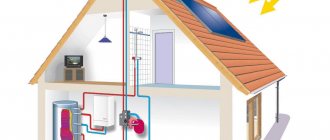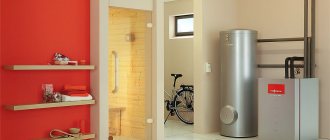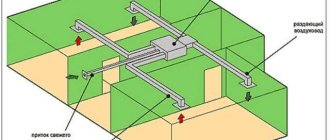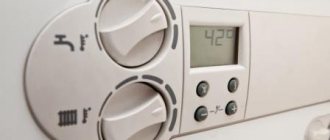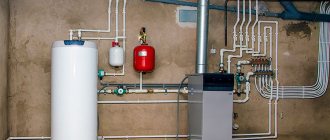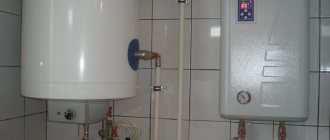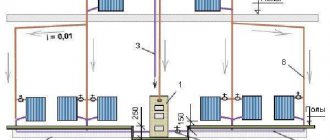How solar collectors work
A solar collector is a functional structure used to generate energy. Its photosensitive elements absorb light to heat the liquid or air inside the tubes.
The principle of operation of a solar collector (SC): the rays of the sun heat the black plates, and the energy is accumulated for domestic needs. The method of obtaining it is environmentally friendly and economical.
The following types of household collectors are distinguished:
- flat;
- vacuum;
- air.
Let's talk more about each of these types below.
Flat
Popular and budget-priced devices. They consist of a flat photosensitive plate connected to heat-conducting pipes, a glass coating, thermal insulation and a metal frame. The plate absorbs sunlight and accumulates thermal energy, which heats the coolant fluid. Unlike other types, they lose a lot of absorbed heat. Ineffective in cloudy weather. High humidity has a bad effect on structural parts.
Vacuum
There are 2 types of vacuum collectors: direct-flow and with indirect heat transfer. The former are used in the warm season, the latter - all seasons. The design is based on a vacuum tube system with a metal rod inside, which contains a coolant fluid. This installation works on the principle of a thermos. Characterized by optimal efficiency.
Air
The principle of operation is similar to flat ones. But air collectors use air as a coolant. Installed for heating houses. Heated air fills the room using air ducts and a fan.
The type of device is chosen based on the purpose of use. The designs are suitable for summer cottages, cottages, village houses and duplexes.
Flat closed solar collectors
A flat-plate collector consists of an aluminum frame, a special absorbent layer - an absorber, a transparent coating, a pipeline and insulation.
Blackened sheet copper is used as an absorber, which has ideal thermal conductivity for creating solar systems. When solar energy is absorbed by an absorber, the solar energy it receives is transferred to a coolant circulating through a tube system adjacent to the absorber.
On the outside, the closed panel is protected by a transparent coating. It is made of shockproof tempered glass with a transmission band of 0.4-1.8 microns. This range accounts for the maximum solar radiation. Shockproof glass provides good protection against hail. On the back side the entire panel is reliably insulated.
Flat-plate solar collectors are characterized by maximum performance and simple design. Their efficiency is increased due to the use of an absorber. They are able to capture diffuse and direct solar radiation
The list of advantages of closed flat panels includes:
- simplicity of design;
- good performance in regions with warm climates;
- the ability to install at any angle with devices for changing the angle of inclination;
- the ability to self-clean from snow and frost;
- low price.
Flat-plate solar collectors are especially advantageous if their use is planned at the design stage. The service life of quality products is 50 years.
The disadvantages include:
- high heat loss;
- heavy weight;
- high windage when the panels are positioned at an angle to the horizontal;
- performance limitations when temperature changes exceed 40°C.
The scope of application of closed collectors is much wider than that of open-type solar systems. In summer they are able to fully satisfy the need for hot water. On cool days, when utilities do not include them in the heating period, they can work instead of gas and electric heaters.
Where to install solar collectors
The main condition for the operation of the collector is an open space where direct sunlight freely reaches at any time of the year. The device is installed in the territories of private houses, where there is no shadow from other buildings and trees. More often, photosensitive plates are mounted on the roof of a building.
A common method is to install several plates, so-called “geofields”. Both pitched and flat roofs are suitable for installation. Due to the large weight of the collector, it is fixed to supporting structures - beams, rafters, etc.
The devices are installed on balconies or horizontal surfaces of the facade. To make it work more efficiently, photosensitive elements in Russia are located strictly on the south side. If they deviate to the west or east, the absorption coefficient of solar rays will decrease.
DHW based on solar collectors and heat pumps
It is possible to heat water only with the help of solar collectors (SC) only during the day, and on sunny days. In the spring-autumn period and summer cloudy days, when a large volume of hot water is required, and solar heat is not enough, it is more effective to use heat pumps (HP) in solar systems, which allow heating water even at night. This creates balance in the domestic hot water supply with minimal energy costs.
The volume of the storage tank(s) with this combination is reduced by four times. It is advisable to use such a layout for residential buildings and agricultural-industrial complexes. If there is a large volume of demand for domestic hot water, the installations are installed using a modular system. This reduces the risk of failures in the hot water supply, provides easy access for monitoring and maintenance, and also significantly reduces energy consumption.
There will be no need for additional auxiliary rooms for large boilers that are installed as large welded non-demountable structures. Recently, air-to-water heat pumps have become most widespread and used. This choice is due to the relatively low price, ease of installation (no need to drill wells), high degree of operational reliability and availability of these systems.
One such heat pump unit is the SWH1-300N, which is a water heater consisting of a 300L stainless steel tank with a heat pump on top. Consuming only 0.44 kWh, this heat pump water heater heats 300 liters of hot water to 60°C in approximately 9-10 hours of operation from the original level (10-15°C). The heating value of a heat pump installation is 1.6 kWh. The tank has the option of connecting solar collectors.
Approximate calculation of DHW consumption
On a sunny summer day, three solar collectors will heat 300 liters of hot water to at least +60 °C during a full daylight hours. Electricity consumption will be approximately 40 W? 8 hours of operation (pump group and solar system control unit), that is, 0.32 kWh. In the evening, most of the hot water (approximately 200 l) can be used up.
During the night, the water will be heated using a heat pump built into the boiler (storage tank) and in the morning there will be hot water in the water heater. Using a storage tank (water heater with HP) with a volume of 300 liters in the solar system, the output is hot water +60 °C in a volume of at least 500 liters per day. The power consumption of a water heater with a heat pump is 0.44 kWh.
The thermal energy generated by the HP is 1.6 kWh. To heat a liter of water by 1 °C, you need to spend 1.16 W of electricity. Thus, let’s calculate its consumption, which would be necessary to heat water from +20 °C at the inlet to +60 °C at the outlet: 200 l? 1.16 W? (60 °C – 20 °C) = = 9.28 kWh. The time spent heating water in a water heater using a heat pump will be 9.28/1.6 = 5.8 hours.
The electricity consumption of a water heater with a HP for heating water in a volume of 200 liters will be: 5.8 hours? 0.44 W = 2.55 kWh per day. The total energy costs for heating 500 liters to +60 °C will be: 0.32 kWh + 2.55 kWh = 2.872 kWh. The cost of electrical energy to heat 500 liters of water in the usual way (using elementary heating elements) will be 23.2 kWh, and the energy savings will be 23.2 – 2.872 = 20.328 kWh per day.
Savings from implementation are calculated depending on established regional electricity tariffs. Let's consider one more option for operating the daily cycle of a water heater with a heat pump, with the connection of the SC in the summer. Water temperature in the supply line (make-up) +10 °C.
Start of work: morning
Let's assume that at 6:00 the water temperature in the boiler is +60 °C. From 6:00 to 8:00, water consumption is approximately 100 liters of hot water. Simultaneously with the hot water consumption of +60 °C, the boiler is filled with cold water (make-up) with a temperature of +10 °C. In this case, the heat pump starts working when the temperature in the boiler drops to +50 °C. The start time of work will depend on the speed of water withdrawal.
Replacing a liter of hot water with t = +60 °C with cold water with t = +10 °C lowers the temperature in the boiler V = 300 l by 0.166 °C. Accordingly, for the heat pump to start working, it is necessary to consume 60 liters of hot water: V = (t1 – t2)/0.166 = (60 – 50)/0.166 = 60 liters. Assuming uniform flow, the water will begin to heat up an hour later at 7:00. Over the next hour, the water will be consumed and heated, and the heating time will be reduced. In reality, the process of water consumption and heating will look like this:
- The first hour of operation - consumption of 60 liters of hot water without turning on the heater and a decrease in temperature from +60 °C to +50 °C. Further water withdrawal from 7:00 to 8:00 will be 40 liters, the temperature in the boiler at 7:00 will be t = +50 °C. This will result in a temperature drop in the boiler of 5.33°C. But running a heat pump for an hour will increase it by 4.59 °C. Thus, it turns out that with a hot water draw of 40 l/h and simultaneous operation of the heat pump, the temperature in the boiler will drop by 0.74 °C for 300 l of water.
- The heat pump water heating is (1600/1.16)/300 l = 4.59 °C per hour of operation of the heat pump.
- The decrease in temperature in the boiler during the second hour of water withdrawal will be 5.33 - 4.59 = 0.74 °C, and by the end of water withdrawal (at 8:00) the water temperature t in the boiler will be 49.26 °C (or 49 °C , if rounded).
- The heating time from 49 to 60 °C will be: 11? 300? 1.16/1600 = 2.39 hours.
Noon
Water consumption will be approximately 60 liters of hot water at t = +60 °C from 12:00 to 14:00. This will result in a temperature drop in the boiler by 8.3 °C: 60? 0.166 = 10 °C or t = 60 – 10 = 50 °C. The heating time to 60 °C will be 10? 300? 1.16/1600 = 2.17 hours. The heat pump will start working at 14:00, operating time is 2.1 hours, ending at 16:10.
Evening time
Water collection starts at 19:00 and ends at 24:00. The total water consumption time is 200 liters in five hours, or approximately 200/5 = 40 l/h. To turn on this heat pump, you need to consume 60 liters of water. After 1.5 hours, the TN will start working at 20:30. The temperature in the boiler at this time is +50 °C. Based on previous calculations, given the operation of the HP and simultaneous water consumption for 3.5 hours of subsequent water withdrawal, the water temperature in the boiler will decrease by 3.5? 0.74 = 2.59 °C and would be 47.4 °C (or rounded to 47 °C).
The time for complete heating of water to +60 °C after the end of water withdrawal will be reduced and amount to 13? 300? 1.16/1600 = 2.83 hours. Heating ends at 4:50. The built-in additional heat exchanger (coil) for the SC in the water heater is connected by main pipelines to the solar panels. Due to the fact that water can be additionally heated by solar collectors, heating time is reduced.
The space occupied by the water heater is minimal. There is no need for a second boiler. The thermal energy received from one Sun-Time-Solar collector on a sunny summer day in the Moscow region is approximately 2 kW. By installing three collectors, you can heat 300 liters of water by approximately +20 °C during daylight hours. Collectors work starts around 9:30 and ends around 18:30.
Brief conclusions
The combination of a heat pump water heater and solar collectors allows you to obtain more hot water during the midday and evening. Such projects can be successfully implemented in multi-storey buildings, large facilities and in the agricultural sector. Note that in this case: the time for heating water at night is reduced; energy consumption is reduced due to the use of SC; the area of equipment placement is reduced; the volume of the storage tank is reduced by up to four times; heat loss is reduced; The number of solar collectors in a solar installation is reduced.
How to calculate collector area
The working surface area of the system is calculated taking into account its type and location features. It should be remembered that the efficiency of the collector depends on the temperature conditions and the amount of solar energy.
Approximate values for summer in Russia per 1 m²: up to 160 kWh per month, the rest of the time - from 20 to 80 kWh.
For hot water supply you will need approximately 100 * 1.16 * 30 = 3.48 kWh. At the same time, 1.16 Wh is the energy that will be needed to heat 1 kg of water by 1 °C.
Heat pumps are used to regulate energy production in hot weather. Also in summer, structures are covered with a thick awning if they generate a lot of energy. The installation plan and area of photosensitive elements are determined individually.
Cost-effectiveness of solar collectors for heating
Before making the final choice, you need to find out how profitable heating with solar collectors is. For example, the heated area of a house located in the south of the country is 155 square meters. m. Taking into account the warm climate and high-quality insulation, the power of the heating system equal to 15 kW will be sufficient for heating, which means the daily energy consumption is 15x24 = 360 kW/h.
First of all, you need to find out the area of the collectors. It is known that a square meter of the Earth's surface at a given latitude receives about 5 kW/h of heat per day. In the cold months, insolation drops to 4 kWh/sq.m.
Based on the efficiency of the collector, from one “square” of its area you can get a maximum of 4x0.8 = 3.2 kWh of energy per day. This means that the collector area cannot be less than 360:3.2=112.5 square meters. m.
Since the price of one source of solar energy is quite high, the calculation of a solar collector for heating shows that the purchase of such equipment will cost a significant amount. In addition, you need to remember that purchasing a heat accumulator, mixing unit and installing wiring also costs money.
Such heat supply systems are energy dependent, because pumping equipment constantly consumes electricity. In addition, in extreme cold at night, you cannot do without additional heat generators, such as, for example, an electric or solid fuel boiler. They will prevent the coolant from freezing.
What should be the angle of inclination of the collector?
The installation angle of the flat solar collector depends on the following factors:
- Region of residence. For the southern regions - 30-35°, for the middle zone - from 40°.
- The time of year when the installation is planned to be used (summer or winter season, year-round). For all-season use, choose an angle that is approximately equal to the geographic latitude of the region. In summer this value is reduced by 15°. In winter, on the contrary, they increase.
- Climatic conditions and precipitation. If the solar system is used in winter, the angle of inclination is made steep so that snow does not accumulate on its surface.
In the accompanying instructions, the manufacturer indicates the optimal angle of inclination for each solar heater. Compliance with all conditions for determining angular inclination values contributes to the most efficient operation of the equipment.
Which solar collector is better to choose?
Each type of solar collector has its own minimum threshold of solar radiation intensity at which they begin to heat the coolant.
A flat solar collector begins to heat up at a solar radiation power of 70-90 W/m2. For comparison, if the flat collector is not covered with glass, then it will begin to heat at a radiation power of more than 200 W/m2.
Tubular solar collectors with vacuum tubes begin to heat the coolant when the radiation power exceeds 20 W/m2.
The solar collector absorbs both direct and diffuse radiation from the Sun. The overall intensity and ratio of different types of radiation varies depending on the time of year and day, and cloud conditions.
For example, in our southern latitudes, the maximum radiation power in December is about 80 W/m2, in April and September 350 W/m2, and in June 600 W/m2. Moreover, in summer the share of direct radiation is approximately 54%, and in winter only 30%.
From the above data we can conclude that in order for the solar collector to bring heat to the house all year round, a tubular solar collector is needed .
Efficiency of flat and tubular solar collectors
A measure of the efficiency of a solar collector is its thermal efficiency. The efficiency of a solar collector is defined as the ratio of the amount of useful energy taken by the coolant to the amount of solar radiation energy that falls on the surface of the collector.
Efficiency - efficiency factor for three designs of flat and one tubular solar collectors
The figure shows graphs of the coefficient of performance - efficiency, for three designs of flat and one tubular collectors. These are approximate characteristics at solar radiation flux density G=700 W/m2. Along the horizontal axis, the reduced (reduced) temperature is equal to =dT/G, K*m2/W, where dT is the difference between the average temperature of the collector coolant and the external ambient air temperature.
Analyzing the graphs, we can draw the following conclusions:
The solar collector operates with maximum efficiency at low values of reduced temperature dT, in a mode with the minimum required coolant temperature.
Moreover, at low values of the reduced temperature, the efficiency of different designs of flat-plate collectors is almost the same.
A flat solar collector, which is characterized by an efficiency graph with a smaller angle of inclination to the horizon (line I in the figure), will provide heating of water at a low density of radiant energy and a fairly low outside temperature - in spring and autumn.
In the summer, under conditions of intense solar radiation, a flat-plate collector has a higher efficiency than a tubular one. For hot water systems operating only in the warm season, it is beneficial to use flat solar collectors . In addition, a flat collector is much cheaper than a tubular one.
Under conditions of low solar radiation intensity, the efficiency of a tubular collector is higher than that of a flat collector. Installing a tubular collector can only be beneficial for year-round heating of water in heating and hot water systems, as well as in northern latitudes. Considering the high cost of a tubular collector, its installation does not always pay off.
Choosing a solar collector for a swimming pool
Taking into account the conclusions made above, to heat the water in a summer pool by literally a few degrees, you can choose any design of a flat collector . The efficiency at a small dT value will be approximately the same for all designs of flat-plate collectors.
It is advantageous to use the cheapest flat-plate collectors with plastic absorbers, which may not have glazing at all.
Since the temperature of the coolant in the collector will not differ much from the temperature of the outside air, heat loss in the absence of glass will be insignificant. In addition, due to the lack of glass, the amount of solar energy falling on the adsorber will slightly increase. Glass always blocks some of the sun's rays.
Solar collector size calculation
Due to the uneven supply of heat from the solar collector, another heating source must be installed in the domestic hot water and heating systems.
It is recommended to choose the performance of the solar collector so that from it you receive no more than 2/3 of the thermal energy required for hot water supply in the house. It is not profitable to use more productive devices - they will not pay off.
For hot water supply in the house, it is enough to choose a solar collector with an area of 1-1.5 m2 per family member.
The solar collector in the heating system is selected so as to receive from it 20-30% of the thermal energy required for heating. The dimensions of the solar collector for heating purposes are selected at the rate of 0.3-0.5 m2 of collector area per 1 m2 of heated area of the house.
For an indoor pool, the area of the solar collector can be 40% of the area of the water surface in it.
In an outdoor pool, the water is heated by a solar collector with an area of 70% of the water surface area.
An example of calculating the size of a solar collector area
Let's calculate the size of solar collectors for a house with a heated area of 200 m2, inhabited by 5 people. The house has an indoor swimming pool with a water area of 30 m2.
The area of solar collectors will be:
- For heating water in a DHW system - 5-7.5 m2
- For a home heating system - 60-100 m2
- For heating water in an indoor pool - 12 m2
Where can I install a solar collector?
The solar collector can be installed anywhere - on the roof, on the wall, on the ground. It is only important to install it at a certain angle to the horizon and in a sunny place.
But most often the collector is installed on the roof. The collector on the roof does not take up space on the site and receives more sunlight - nothing shades it there.
On the roof, the collector is installed above the roof. There are collector designs that are built into the roof covering.
When installing in any location, please note that the device requires maintenance. Therefore, it is necessary to think about how to facilitate access to it.
In addition, the collector is a fairly heavy device . therefore, the roof rafters or the wall of the house may require reinforcement of their structure.
It is best to provide for the installation of a solar collector immediately, at the stage of design and construction of a house.
Solar collector surface orientation
The collector will receive the maximum amount of solar energy if its surface is perpendicular to the direction of the sun.
The direction of the sun constantly changes depending on the time of year and day. Therefore, the collector is installed at a certain angle to the horizon, which allows you to receive maximum solar energy without changing the position of the collector .
A solar collector that will work all year round is installed at an angle to the horizon, the value of which is approximately equal to the geographic latitude of the area.
In winter, if possible, it is better to increase the angle of inclination by about 15°.
If the solar collector will work only in summer , then the angle of inclination should be reduced to: geographic latitude of the area minus 15o.
The plane of the solar collector should face south with an accuracy of plus or minus 15o .
Tubular vacuum collectors allow greater deviation from the south direction. They must be illuminated by the sun for at least six hours a day.
More Articles on this topic:
⇒ Hot water supply for a private country house
⇆
More articles on this topic
- Apartment redevelopment - fresh ideas
- How to connect electricity to your home
- Frame house with communications - features and advantages
- Laying walls from aerated concrete and gas silicate blocks
- Attic floor, attic - advantages and disadvantages
- Magnesium or aluminum anode for water heater
- House made of large-format porous ceramic blocks
- Installation of a built-in shower made of tiles in a bathroom or toilet
Necessary tools and materials for installing a solar collector
Installation of solar collectors is carried out outdoors. Consequently, the structure itself, the pipeline system and all auxiliary fastenings are subject to environmental damage over time. They may experience corrosion and deformation. Therefore, only stainless materials are used for installation.
To install the solar collector, use the following auxiliary tools:
- crane or lift;
- scaffolding;
- roof ladder;
- safety equipment - vest, rope, etc.;
- building level;
- vacuum grip;
- insulating material for pipes.
The reliability, efficiency and durability of the equipment depend on the quality of installation.
Making a solar collector with your own hands
One of the disadvantages of industrially produced solar collectors is their high cost. Indeed, not everyone has the available funds to pay for the availability of hot water in their dacha. The solar water heater option can be solved by making it yourself. The characteristics of such a water heater will be much inferior to the factory one, but in order to wash your face and wash dishes in a summer cottage, the temperature and water flow will be quite enough.
To make a solar collector with your own hands, you select materials that are lying idle in the utility room or, in extreme cases, they can be bought cheaply at a regular hardware store. The cost savings compared to purchasing an industrial design are quite significant.
For self-production, a flat solar collector is taken as a prototype. It is almost impossible to manufacture a vacuum manifold privately. The main task in the manufacture of a homemade solar collector will be the selection of suitable materials for the adsorber - the main structural unit responsible for the performance of the device. There are options where craftsmen from the people use cheap improvised materials instead of expensive copper and aluminum.
- Adsorber made of corrugated stainless steel pipe.
Stainless steel in this form easily bends in any direction, which is important in the manufacture of an adsorber coil. High thermal conductivity and corrosion resistance increase the efficiency and service life of a collector with such an adsorber. - Adsorber made of plastic pipes.
Plastic materials are inferior in thermal properties to copper and aluminum. However, the technological properties in the manufacture of heat exchangers of complex shapes and resistance to corrosion, along with low cost, make this material in demand in the manufacture of home-made water heating installations. - Adsorber from beer cans. Containers for beer and other drinks in the form of cans are made of food-grade aluminum. Folk craftsmen have adapted a material with good thermal conductivity properties for heat exchangers in solar collectors. After opening the top and bottom parts of the cans, they are glued together with heat-resistant glue.
After assembly, the light receiver from the cans is painted black and can accumulate thermal energy during the daytime.
In addition to the above options for manufacturing solar homemade water heating devices, there are many designs invented by folk craftsmen: from plastic bottles, rubber hoses and others.
There is a strong opinion that the use of solar collectors gives a visible effect only in the southern regions, where there are many sunny days. However, if you pay attention to the geography of solar installation users, you can find positive reviews from people living near Moscow, which is far from the south. With the improvement of solar collector production technology and rising gas prices, the geography of their application will increasingly expand, including at latitudes closer to the north.
Solar collector connection diagrams
When installing a solar water heater or heating system, a storage tank must be connected to the device. It is needed due to the disproportionate energy consumption and distribution of generated heat. Over time, the tank fills with water, which the system owners use at their discretion.
It is recommended to install a standard boiler or buffer tank. A rationally constructed design is a connection of a collector with a heat conductor, which communicates with the boiler.
For home heating
In the northeastern regions of Russia, there is no maximum solar activity in autumn and winter. Solar power plants are used as an auxiliary energy source for heating. The connection diagram is shown in the figure below.
The solar collector is connected to the water supply and a circulation pump. The energy is used to indirectly heat the room.
For hot water supply
There are 2 options for use: for summer and winter.
The first one is suitable for summer residents. They heat water only in summer. Therefore, such an installation has minimal inertia. It is necessary to install the solar collector below the level of the storage tank so that the water circulates naturally.
In winter, antifreeze is used as a coolant fluid, which is poured into a storage tank with a coil. Due to its continuous circulation, the water is constantly heated to the optimal temperature.
Heating + hot water
The essence of the connection diagram is the combination of heating and domestic hot water processes. A double-circuit heat-storing tank with an internal reservoir is used. This helps separate process water from drinking water. For automation, an SC controller is included in the circuit to prevent overconsumption.
For heating the pool
To warm up a portable or stationary pool, use a submersible pump. It can be replaced with an automated pumping station, which will circulate cold water from the pool, and heated water from the SC.
Automation of heating and hot water systems with a solar collector
Heating and hot water systems with a solar collector must be equipped with automation devices.
Automation is necessary for coordinated control of the operation of several energy sources - solar collector, boiler, electric heater, as well as circulation pumps.
Sensors measure the temperature of the coolant at heating sources and the temperature of water in the storage tank. The control unit, according to a given program, analyzes the indicators of the sensors and issues commands to turn on or off certain heating sources, pumps and valves.
A person has the opportunity to set control parameters - for example, set the maximum temperature of hot water.
Installation and cost of connecting a solar collector by specialists
Installing solar collectors is a labor-intensive task. If you have experience in such work, you can do the installation yourself.
Before installation, it is recommended to study the instructions and read information on specialized forums. Installation of the popular IC “Soltek” and Solar Fox can be viewed in a special video instruction.
Installation of the solar collector and its connection to the water supply can be ordered from certified companies. The installation price depends on the region, the minimum amount is 12,000 rubles. The estimate includes external and internal work.
The use of collectors for partial or full heating and hot water supply is a rational solution. This is an environmentally friendly and affordable way to generate energy that will help you save on utility bills.
Advantages and disadvantages of solar collectors
The main advantages of solar water heaters:
- use of an inexhaustible and absolutely free source of energy;
- the consumption of traditional energy sources - gas, oil, coal - is reduced;
- opportunity to work all year round;
- you can easily reduce or increase heat by removing/adding the number of sections;
- changes in energy prices do not affect the functioning of solar power plants;
- Reliable operation, convenient operation for a long time.
Main disadvantages:
- the cost of the solar collector itself and its installation along with the harness with all the additional elements will cost a considerable amount - this is quite an expensive pleasure:
- It is not always possible to ensure effective autonomous operation of a solar collector due to the intermittent presence of the sun in the sky, therefore the use of a collector alone without additional energy sources does not meet human needs for thermal energy.
